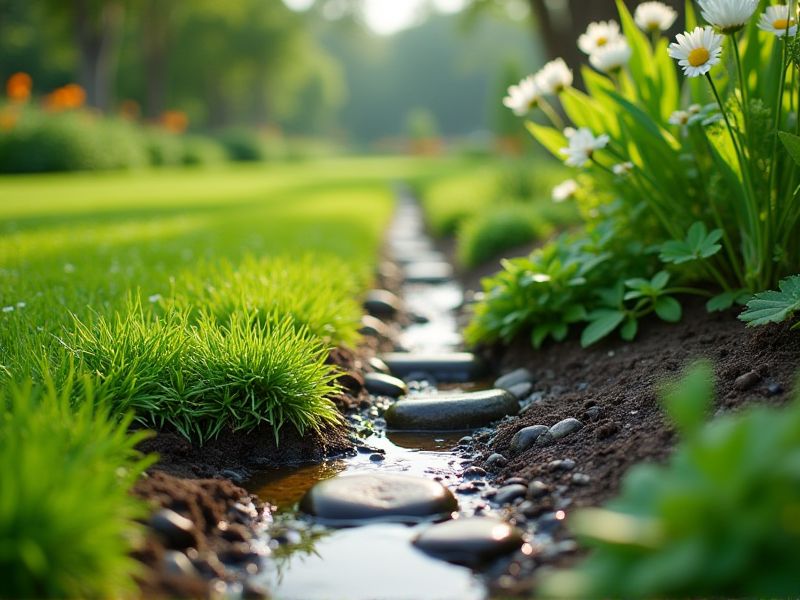
Drainage plants play a crucial role in preventing waterlogging by effectively managing excess moisture in the soil. Species such as bulrush (Schoenoplectus spp.) and cypress (Taxodium distichum) are known for their ability to thrive in wet conditions while facilitating water movement through their root systems. These plants not only help in absorbing and utilizing water but also improve soil aeration, promoting healthier root development for surrounding vegetation. Implementing drainage plant systems in agricultural fields or gardens can significantly reduce the risk of root rot and other water-related diseases. By strategically planting these species, you can enhance your landscape's resilience to flooding and enhance overall soil health.
List of some Drainage plants that prevent waterlogging
- Cattail (Typha latifolia)
- Marsh Marigold (Caltha palustris)
- Yellow Flag Iris (Iris pseudacorus)
- Soft Rush (Juncus effusus)
- Pickerelweed (Pontederia cordata)
- Sweet Flag (Acorus calamus)
- Cardinal Flower (Lobelia cardinalis)
- Giant Reed (Arundo donax)
- Switchgrass (Panicum virgatum)
- Blue Flag Iris (Iris versicolor)
Important things about Drainage plants that prevent waterlogging
Function Of Drainage Plants
Drainage plants play a crucial role in managing excess water in agricultural and urban landscapes, effectively preventing waterlogging. By utilizing their deep root systems, these plants enhance soil structure and permeability, allowing for improved water absorption and decreased surface runoff. Species such as willows and reed beds are particularly effective, as they not only absorb excess moisture but also filter pollutants, promoting healthier ecosystems. Incorporating these drainage plants into your landscaping can significantly improve water management, ensuring optimal conditions for other plants to thrive.
Types Of Drainage Systems
Drainage systems, such as surface drainage, subsurface drainage, and bioretention systems, play a crucial role in preventing waterlogging in agricultural and urban environments. Surface drainage utilizes grading and ditches to direct excess water away from landscapes, reducing the risk of flooding. Subsurface drainage involves the installation of perforated pipes beneath the soil surface to remove excess moisture and improve soil aeration. Bioretention systems, like rain gardens, effectively manage stormwater by promoting infiltration and filtration, contributing to sustainable drainage practices while enhancing biodiversity.
Soil Permeability Impact
Soil permeability significantly affects drainage systems designed to prevent waterlogging in agricultural and landscaped areas. High permeability facilitates efficient water movement, allowing excess moisture to drain quickly, which helps maintain optimal soil aeration and root health. Conversely, low permeability can lead to waterlogged conditions, negatively impacting plant growth and potentially causing root rot. Implementing effective drainage techniques, such as installing perforated pipes or creating swales, can enhance soil permeability and promote sustainable land management.
Maintenance Requirements
Regular maintenance of drainage systems is crucial to prevent waterlogging and ensure optimal functionality. Routine inspections should focus on clearing debris, sediment, and vegetation that can obstruct flow in drains and culverts. You should also consider checking for structural integrity, as cracks or collapses can significantly impede water movement. Implementing periodic hydraulic testing will help assess the system's efficiency and identify areas needing repairs or enhancements, ultimately safeguarding your landscape from excess moisture.
Role Of Native Vegetation
Native vegetation plays a crucial role in enhancing drainage and preventing waterlogging by promoting healthy soil structure and increasing water infiltration. Deep-rooted native plants, such as grasses and trees, help to break up compacted soil, allowing excess water to drain away more efficiently. The presence of diverse root systems not only stabilizes the soil but also improves its capacity to absorb and retain moisture, preventing standing water issues. By incorporating native plant species in your landscape design, you can significantly contribute to effective drainage solutions while supporting local ecosystems.
Environmental Benefits
Drainage plants play a crucial role in preventing waterlogging, thereby enhancing soil health and agricultural productivity. By absorbing excess moisture, these plants help maintain optimal soil aeration, which is essential for healthy root development. Additionally, their root systems promote improved drainage and reduce soil erosion, contributing to ecosystem stability. Implementing drainage vegetation not only safeguards crops but also supports biodiversity by providing habitats for various organisms.
Water Management Practices
Effective drainage plants are essential for optimal water management, preventing waterlogging in agricultural fields and urban areas. These systems utilize subsurface drainage, retention ponds, and natural waterways to redirect excess water away from land, enhancing soil health and crop production. By implementing proper drainage techniques, you can improve land usability and mitigate flooding risks. Monitoring and maintaining these drainage systems ensures they remain functional, safeguarding against the adverse effects of waterlogging.
Importance Of Proper Installation
Proper installation of drainage plants is essential to prevent waterlogging in agricultural and urban environments. Efficient drainage systems facilitate the timely removal of excess water, ensuring that soil remains aerated and healthy, which is critical for crop growth and infrastructure integrity. Effective drainage reduces the risk of water-related diseases in plants and minimizes flooding risks, ultimately enhancing land productivity and property values. By prioritizing correct installation techniques, you can safeguard your investments and promote sustainable land use.
Effects On Local Wildlife
Drainage plants play a crucial role in managing excess water, preventing waterlogging that can adversely affect local wildlife habitats. By enhancing soil aeration and reducing stagnant water, these plants create a more balanced ecosystem, benefiting flora and fauna alike. Many species of birds, insects, and small mammals thrive in areas with well-drained soil, as it supports a healthy food chain and promotes biodiversity. Implementing effective drainage strategies not only safeguards your property from flooding but also fosters a thriving environment for local wildlife.
Cost Considerations And Budget Planning
When planning a drainage system to prevent waterlogging, it's crucial to assess the costs associated with design, materials, and construction installation. Budget-friendly options may include perforated pipes, trench drains, or bioswales, all of which can be effective in managing excess water. You should also factor in long-term maintenance expenses, as regular inspections and repairs can substantially impact overall costs. Understanding local regulations and permitting requirements is essential, as these can influence both upfront expenses and potential future modifications to your drainage system.
